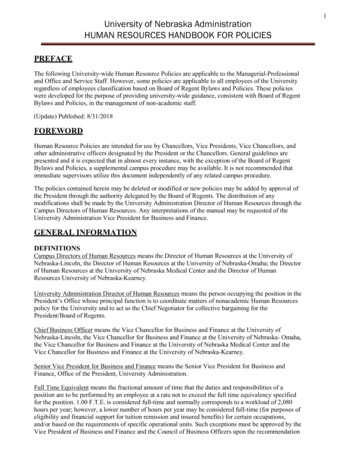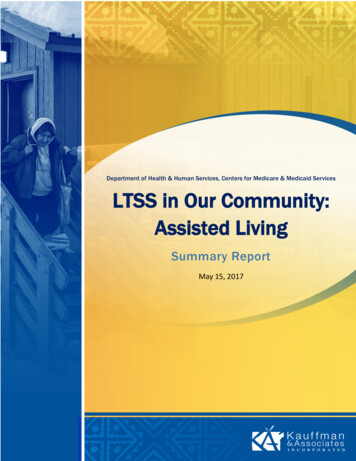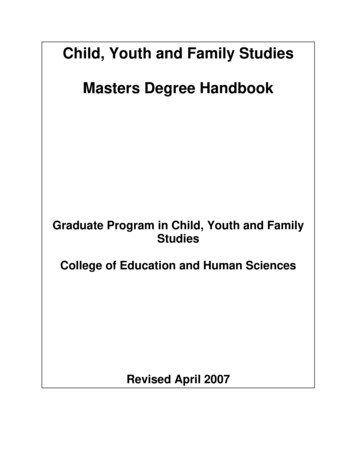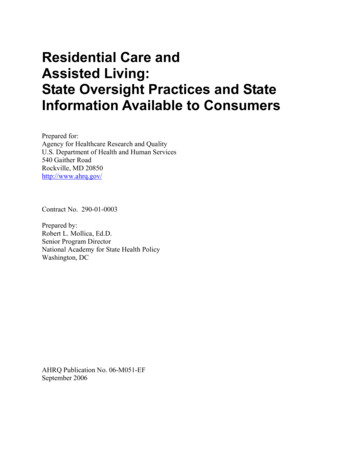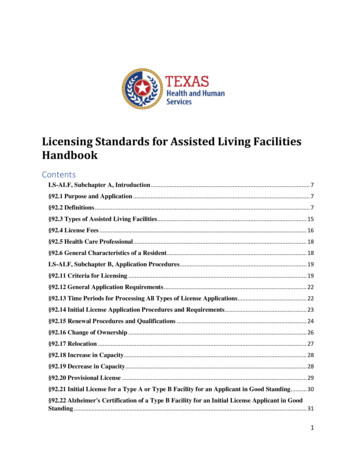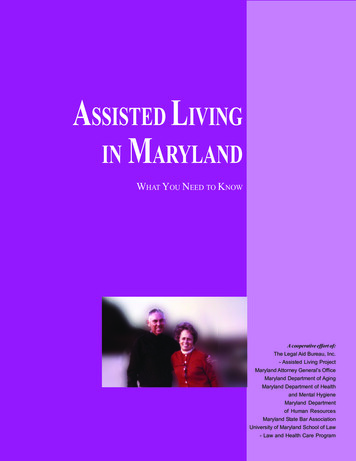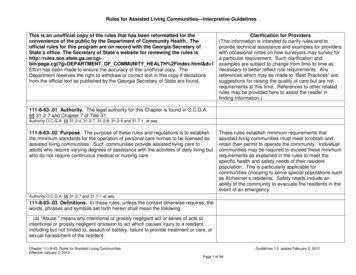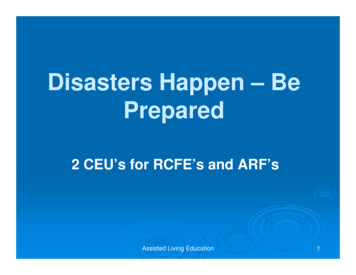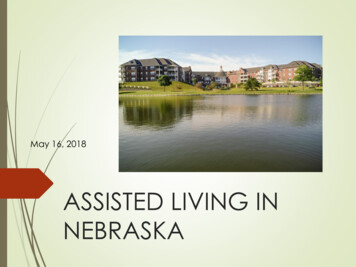
Transcription
May 16, 2018ASSISTED LIVING INNEBRASKA
PRESENTER John Croghan, Executive Director at The Landing atWilliamsburg Village jcroghan@Immanuel.com
How did we get to this point?In Nebraska, a facility that provided nonmedical, residential care was licensed as adomiciliary or board-and-room home andwas typically an older home with bedroomsand common areas
How did we get to this point?Nebraska seniors wanted anon-medical option that providedassistance, but also supportedtheir independence, privacy andchoice
How did we get to this point? A collaborative group representingdiverse interests came together tocraft assisted living in Nebraska After research and discussion, theconsensus was to base the design ona social model
How did we get to this point?In 2000, assisted living became law,the prior domiciliary and room-andboard statutes were repealed andregulations were developed
How did we get to this point? In 2003, in response to calls for changes to assistedliving, a legislative study group was convened Again, the consensus was to retain the socialmodel, with the addition of a very limited role for thenurse Staff training and competency requirements werealso added In 2004, these changes to assisted living were putinto law
What IS and ISN’T Assisted Living?SOCIAL MODELRATHER THAN MEDICALHome-like environmentSocial opportunities, ActivitiesSelf-direction and decision makingPrivacy, Dignity, Individuality, Independence
What IS and ISN’T Assisted Living?STAFFAdministratorNurse or Nurse ConsultantCertified Nursing AssistantsMedication Aides, ActivitiesOthers depending onstructure of Community
What IS and ISN’T Assisted Living?ROLE OF THE NURSELimited scope of practiceAllowable Activities:Nurse assessmentReview of medication administration policiesMedication aide training responsibilityHome Health and Hospice providers in ALResident management of medication
What IS and ISN’T Assisted Living?STABLE AND PREDICTABLERATHER THAN COMPLEX CAREStable – resident’s clinical status andneeds are consistent and non-fluctuatingPredictable – resident’s status andneeds fluctuate in an expected mannerwith planned interventions
Assisted Living in Rural AreasMay be a stand-alone facilityMay be connected to a nursing facilityADVANTAGES:Area residents can remain close to homeCommunity interaction and involvementCaregivers tend to be from the areaCHALLENGES:Other health care providers may not be closeFewer transportation options
Assisted Living in Urban AreasMay be a stand-alone facilityMay be part of a continuum of careADVANTAGES:May have several choices of AL facilitiesMore transportation optionsClose to other health care providersCHALLENGES:Competition with other AL for staffHospital network may exclude some AL
Transitions to and from AssistedLiving Complete history and forthright communication,key for successful transition to Assisted Living Who is the point person at the AL facility? Clear Expectations: Resident, family, referralsource, physician, other providers or caregivers Prevention of HospitalReadmissions
Risk FactorsRisk analysis (falls, chronic healthconditions, cognitive decline, etc.)Preventative Measures, Observation ofChangesInvolvement of Home Health,Companions, family, etc.Assisted living is still limited if conditionis not stable or predictable
Nebraska Significant variations from AL Community to ALCommunity
AL Communities are regulated byeach State (no Federal oversight) Significant differences from state tostate in AL regulation Significant growth across theUnited States in Assisted LivingCommunities
Future of AL in Nebraska Coalition Role of the nurse Regulatory challenges
Future of AL in Nebraska Perception of AL by others Education about AL Consumer expectations Role Nurse and support staff
AL Legislative Bill 439 andLB439A (fiscal note)passed on April 11, 2018unanimously.
Staffing Requirements An Assisted Living Community in Nebraskamust have an administrator who isresponsible for the overall planning,organizing, and directing the day-to-dayoperation of the facility Administrator is responsible for maintainingstaff with appropriate training and skills tomeet resident needs as defined in theresident service agreements AL Community must provide for an RN toreview medication administration policiesand procedures and to provide or overseetraining of medication aides at the facilitySource: National Center for Assisted Living (2013)
Staff TrainingOrientation within two weeks for ANY staff providingdirect care (routine staff, float, universal workers, etc.) Resident Rights Resident Service Agreements Infection Control Practices Emergency procedures and Advance Directives Info on any physical, mental, or special caresneeds of residents Education on Abuse, Neglect, andmisappropriation of resident funds and reportingprocedures Disaster Preparedness Confidentiality
Ongoing training12 hours per year from date of hire Appropriate to job duties Meet physical, mental, and special needs ofresidents Four of the 12 hours must relate specifically toAlzheimer's/Dementia for certified Dementia unitsRecord of training to include: name of employee,date, length of training, name of trainer. Must haveclear policies.
Med Aide trainingOngoing Competency trainingby RN Procedures for storing, handling, andproviding meds Procedures for documentation of meds Procedures for documenting andreporting med errors and adversereactions ID person responsible for direction andmonitoring of MA’s Other resident specific training onproviding meds
OSHA requirements Blood borne pathogen standards (annual) Lock out/tag out procedures (annual) Prevention of transmission on TB (periodic) Workplace violence suggested Ergonomic standards suggested
Continuing Care RetirementCommunities (CCRC) A residential alternative which provides flexible housingoptions, a “coordinated” system of services and amenities anda continuum of care that addresses the varying health andwellness needs of residents Independent, Assisted, Skilled NF, Memory Assist, Hospice, Carenavigation, HCBS Helps avoid multiple moves Services typically on one campus Most offer Life Care contracts
CCRC’s history Some as far back as 100 years ago “Purpose Built” Roughly half are faith based 82% non profit Most part of multi-site system Typically 300 or less total units, but someover 500Today’s Continuing Care RetirementCommunity (CCRC)CCRC Task Force, Jane E. ZaremJuly, 2010
CCRC’S Benevolent Care Entrance fees and Monthly fees Attractive to those with children who may notlive close Attractive to couples who remain close tospouse when care needs change.
CCRC’s located in 48 statesPennsylvania, Ohio, California,Illinois, Florida, Texas, Kansas,Indiana, and North Carolinahave the largest number ofCCRC’sZiegler National CCRC Listing and Profile, 2009
The future of CCRC’s looks bright
QUESTIONS?
Gotta Have Fun
staff with appropriate training and skills to meet resident needs as defined in the resident service agreements AL Community must provide for an RN to review medication administration policies and procedures and to provide or oversee training of medication aides at the facility Source: Na
